In this article, Be The Change’s Environmental Director, Phil Doe, dissects the propaganda put forth by the oil and gas industry in response to Proposition 112.
Download the PDF version Here:
Prop 112 Fact Sheet
Drowning in a Vat of Oily Propaganda: the oil industry’s assault on the people and Proposition 112
Fact 1: Prop 112 Protects Public Health 2
Fact 2: Fracking Increases Cancer Risks 4
Fact 3: Fracking Increases Infant Health Risks 5
Fact 4: Fires And Spills Occur Frequently At Fracking Sites 6
Fact 5: Fracking Contaminates Water 7
Fact 6: Fracking Degrades Air Quality 8
Fact 7: There Is Overwhelming Evidence That Fracking Is Hazardous 9
Fact 8: Denver Is Not Immune To Fracking 10
Fact 9: Prop 112 Is A Setback, Not A Ban 13
Fact 10: Federal Land Is Not Affected 15
Fact 11: Existing Wells Are Not Affected 16
Fact 12: The Impact On Jobs Is Minimal 17
Fact 13: Oil Is A Minor Economic Driver 19
Fact 14: Severance Taxes Have Recently Been Near Zero 20
Fact 15: Water Use For Fracking Is Not Sustainable
Fact 1: Prop 112 Protects Public Health
Colorado Oil and Gas Association spokesman Scoot Prestidge said, “A 2,500-foot setback (Proposition 112) would shut down Colorado’s oil and natural gas industry and lead to a massive layoff of over 100,000 local jobs.”
The clear purpose of the 2500-foot setback required in Proposition 112 is to protect public health and safety. Scientific studies show the state’s present 500-foot setback requirement is grossly inadequate, and 2500 feet would constitute a minimum requirement. Spending over $38 million already in a propaganda blitz, most of it from out of state (see Colorado Secretary of State, Campaign Finance), the industry has bombarded the airwaves with a few well-tailored lies to convince the public that a square is really a circle–and that fracking near homes and schools is safe, necessary, and desirable.
Fracking is safe, until it isn’t
 (Photo from denver.cbslocal.com) Fire at fracking site in Windsor northeast of Denver. The fire was caused by an uncontrolled release of toxic gasses during its drilling completion phase. The leak lasted 16 hours before the fire and explosion. The well leaked for another 16 hours before it could be contained. An atmospheric benzene spike was measured 40 miles away at the Boulder County air quality station, the only continuous air monitoring station in the state.
(Photo from denver.cbslocal.com) Fire at fracking site in Windsor northeast of Denver. The fire was caused by an uncontrolled release of toxic gasses during its drilling completion phase. The leak lasted 16 hours before the fire and explosion. The well leaked for another 16 hours before it could be contained. An atmospheric benzene spike was measured 40 miles away at the Boulder County air quality station, the only continuous air monitoring station in the state.
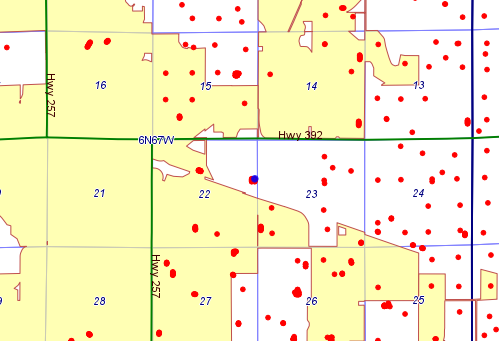 Map of existing active and closed wells in and near Windsor on a common section map—each section is one square mile. The bigger dots represent newer horizontal wells with multiple wells on each pad, the smaller dots represent older single wells. The blue dot shows the location of the Windsor (Stromberger) fire. Although the well pad looks to be less than 500 feet from the city boundary, this section of the city is largely industry, with some residential housing about 1 mile away. However, one home about a 1/4 of a mile north of the fire and explosion had to evacuated as it became engulfed in flames from the well pad. It did not burn, miraculously.
Map of existing active and closed wells in and near Windsor on a common section map—each section is one square mile. The bigger dots represent newer horizontal wells with multiple wells on each pad, the smaller dots represent older single wells. The blue dot shows the location of the Windsor (Stromberger) fire. Although the well pad looks to be less than 500 feet from the city boundary, this section of the city is largely industry, with some residential housing about 1 mile away. However, one home about a 1/4 of a mile north of the fire and explosion had to evacuated as it became engulfed in flames from the well pad. It did not burn, miraculously.
Fact 2: Fracking Increases Cancer Risks
People who live within 500 feet of a well in Colorado may experience a lifetime cancer risk eight times higher than EPA’s upper acceptable levels. Benzene leaks from the wells are thought to be the primary cause of this risk increase. (McKenzie) Consider for a moment what terror that would create in you if your family were so threatened.
Fracking is safe—Until it isn’t
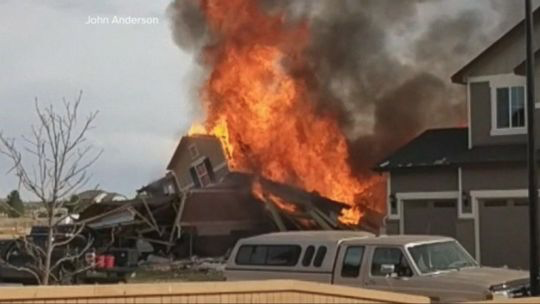
(Photo from abcnews.go.com) This explosion on April 17, 2017, killed 2 people and seriously injured another. Anadarko, the oil company responsible for the gas leak from a nearby well has settled with the survivors for an undisclosed amount. Stock holders and a Pennsylvania retirement fund are suing Anadarko for malfeasance, most of it unrelated to this managerial disaster.
Fact 3: Fracking Increases Infant Health Risks
Infants born within about 1/2 mile of fracked wells are 25 percent more likely to have lower birth weights than infants born farther away, with the prospect that they will be lower achievers and less healthy as adults. Low birth weight is a symptom of benzene exposure, a known air pollutant and carcinogen associated with fracking.
Fracking is safe—Until it isn’t
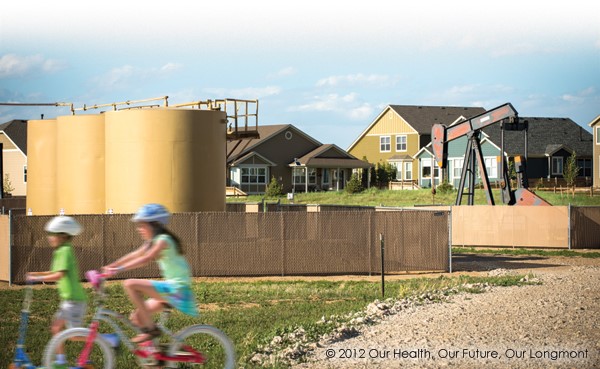
Put yourself in the place of parents whose children are reduced to playing regularly next to oil and gas wells and connecting storage tanks, all emitting toxins.
Fact 4: Fires And Spills Occur Frequently At Fracking Sites
Opponents of prop 112 have no scientifically vetted studies behind their claims, just splashy propaganda bankrolled by at least $38 million in corporate oil and gas money, over $20 million spent already. On the other hand, it is well documented that a polluting fire/explosion occurs at a fracking operation every month. Spills of toxic liquids occur at the rate of about a dozen per week, sometimes flowing directly into waterways. Altogether, companies spilled more than 93,000 gallons of oil into soil, groundwater and streams in 2017. They also spilled more than 506,000 gallons of toxic, radioactive, fluids from producing wells. This is self reported by the industry, so there is no way to assess the accuracy of these numbers.
Fracking is safe—Until it isn’t
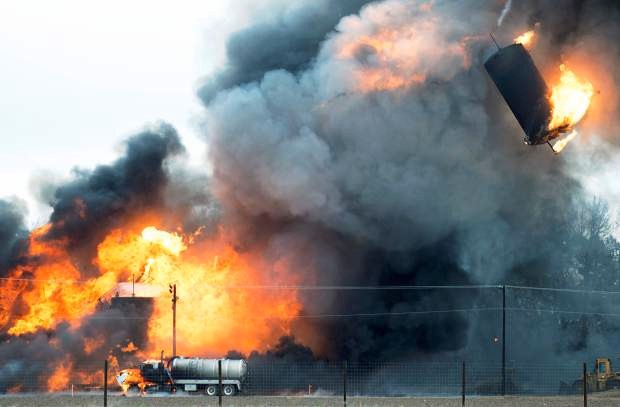 (photo from dailymail.co.uk)
(photo from dailymail.co.uk)
Explosion of a storage tank at a fracking waste site north of Greeley. Note the tank being lifted into the air by the explosion. It actually went airborne like shot from a missile silo. Miraculously no one was killed. The same could not be said if this had occurred within 500 feet of homes.
Fact 5: Fracking Contaminates Water
Twenty two domestic water wells have been reported as contaminated by fracking operations–a number suppressed by operator payoffs and nondisclosure agreements. Want to be within 500 feet of such negligence?
Fracking is safe—Until it isn’t
 A well sight near a water course. Numerous sites such as this were compromised during the 2013 flood that hit northern Colorado. Their product, all poison, whether operational waste or oil, was carried, uninvited, downstream. Is the requirement that new well sites be 2500 feet from water courses unreasonable as the industry claims?
A well sight near a water course. Numerous sites such as this were compromised during the 2013 flood that hit northern Colorado. Their product, all poison, whether operational waste or oil, was carried, uninvited, downstream. Is the requirement that new well sites be 2500 feet from water courses unreasonable as the industry claims?
Fact 6: Fracking Degrades Air Quality
The air quality on the front range is severely compromised by ozone contamination, which is created by VOCs that are cooked by sunlight to form ozone. The state and the industry have agreed that 55 percent of the VOCs on the front range come from oil and gas operations to the north, primarily Weld County. The federal ozone standard is 70 ppb. Many areas along the front range, especially those that trap VOCs against the mountains, have ozone readings that exceed 80 ppb for extended periods. Ozone is a major cause of asthma. It can cause strokes, heart attacks, and nose bleeds and rashes, particularly in children. A recent study out of MIT estimates that if we don’t sharply reduce industrial pollution, of which fossil fuels are a major contributor, the costs to the planet from ozone pollution by 2050 will be $838 billion, accompanied by 2 million deaths annually.
Fracking is safe—Until it isn’t
 Visualize a Sunday afternoon backyard barbeque with the kids to the accompaniment of the relentless whir and belching of the industry’s steel behemoths just over the fence.
Visualize a Sunday afternoon backyard barbeque with the kids to the accompaniment of the relentless whir and belching of the industry’s steel behemoths just over the fence.
Fact 7: There Is Overwhelming Evidence That Fracking Is Hazardous
The New York Compendium, which is used internationally as a reference manual on fracking is updated regularly. It now contains over 1300 findings, from scientific, medical, and journalistic investigations. They combine to demonstrate that: “Fracking poses significant threats to air, water, health, public safety, climate stability, seismic stability, community cohesion, and long-term economic vitality.” From a review of 685 recent, peer-reviewed publications on fracking, 84% indicated health hazards, risks or adverse outcomes; 69% reported water contamination, and 87% found air pollution. The Compendium concluded that regulations (such as those of the COGCC) are simply not capable of preventing harm. Most of the dangers and costs of oil development do not occur for renewable energies, which, in any case, are already cheaper.
Fracking is safe—Until it isn’t
 In frack-land there truly is nothing quite like an evening stroll through the neighborhood
In frack-land there truly is nothing quite like an evening stroll through the neighborhood
Fact 8: Denver Is Not Immune To Fracking
You can’t build a condo in Denver’s City Park or Washington Park, but you could frack them with the Governor’s blessing
The state’s present 500-foot set-back rule would allow a pad with 20 wells or more to be drilled in Denver’s City Park with Governor Hickenlooper’s support, since, in his opinion, as a former oil and gas industry geologist, the rights of mineral owners are superior to those of other citizens and even local governments, themselves. He also claims fracking is safe despite overwhelming scientific evidence to the contrary, as noted above.
Denver’s other iconic park, Washington Park could also be fracked under the present setback requirements—visualize, if you will, twenty wells on a five acre pad near the center of the park where presently residents lawn bowl on manicured grass lanes. And, near the very spot where the old and magnificent Hawthorne tree brought from Mount Vernon stood for over a hundred years.
 Innocent looking Lawn bowling pad in Washington Park. Someday a pad for 20 wells???
Innocent looking Lawn bowling pad in Washington Park. Someday a pad for 20 wells???
Under 112, both parks would be saved. City Park, at about one square mile, could otherwise, from the 2500 setback perspective, accommodate a five-acre well pad at its center with 20 or more wells extending 4 miles into adjoining neighborhoods. The setback requirement from the lake at the park, however, could not be met.
Washington Park would also be saved. Though South High School at the south end of the park, and the expensive condos at the north end would both be over 2500 feet from the center of the park. Its two lakes and its relative narrowness would save it under Prop 112.
Conclusion:
While admittedly hypothetical, the fracking of Denver’s two largest and oldest parks is not outrageously speculative or hyperbolic. Both parks, like the city itself, are underlain by the same shale formation (Niobrara) being fracked north and east of the city. They have not been fracked because they do not yet support the infrastructure needed to get the product to markets, namely a warren of underground pipelines and above ground storage facilities. It is also thought to be not as rich in deposits as other areas or the Niobrara to the north. But make no mistake, if we do not move toward renewables for our electricity with deliberate speed, these iconic public landmarks could become sacrifice zones to our need for more oil and gas.
The appropriation of public open space has already happened in many urbanized areas to the north of Denver where dedicated open space has been surrendered to the frackers with the blessings of the state’s agency, the COGCC. It is given dictatorial powers by the legislature over all things oil and gas in the state. Recently for example, four open space parcels in Boulder County were awarded to the oil industry as well sites for fracking. The people of Boulder County have spent an estimated $100 million protecting land for themselves and future generations through ballot measures to buy and protect open space. Many other counties have made similar public investments.
What this award by the COGCC amounts to is the state appropriating public park land for the frackers, at basically no cost to them, after the people have already bought it to protect it from development. Talk about a dipsie doodle in double dealing! The county is reluctantly suing on behalf of its citizens, but clearly, under the right administration and weak local leadership, the parks in all cities, are fair game for the oil industry.
Understanding and sympathy are important for democracy to work. Please vote for 112 in defense of your fellow citizens and our public places.
Industry Propaganda: If I can’t drill in your neighborhood, or next to your school, you are putting me out of business!
Only days after the oil industry and the governor found out that over 170,000 Colorado registered voters had signed petitions to get Proposition 112, nee Initiative 97, on the November ballot, the Colorado Oil and Gas Commission came out with an announcement that Proposal 112 would make 85 percent of the private land in the state unavailable to drilling.
Fact 9: Prop 112 Is A Setback, Not A Ban
First of all, drilling is done underground not on the surface. It is called drilling for a reason, after all. The well laterals are 2 to 3 miles long and usually run in opposite directions underground from the well pad on the surface. The distance between laterals is set at about 500 feet so that they do not intercept each other and wreck production. The area underground that can be fracked from one well pad is from 2560 acres (20 wells covering an underground area 1 mile by 4 miles) up to 7680 acres (40 wells covering an underground area 2 miles by 6 miles).
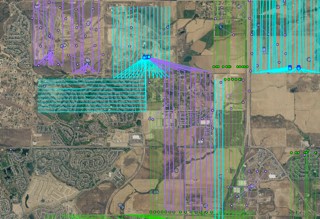 40 wells proposed by Extraction Oil and Gas next to homes in Weld County. But for the luck of the draw one of the many homes in this birds-eye view could be yours.
40 wells proposed by Extraction Oil and Gas next to homes in Weld County. But for the luck of the draw one of the many homes in this birds-eye view could be yours.
We are being asked to believe that a 5 to 10 surface acre footprint could not be reasonably found sufficient to mine an underground area of up to 7680 acres. If you wanted to drill the entire state, all 100,000 square miles of it, you would need only about 8300 well pads.
To be sure, sighting of surface wells will become more restrictive under 112 since wells can’t be drilled next to our homes, our parks and open space, or our water ways, but it is simply an incredible claim that the industry would be put out of business, since the surface area required to drill 7680 acres is well less than 1 tenth of one percent of the underground footprint. This is the biggest lie, and the lie most often repeated.
And keep in mind that even with a 2500 setback drilling might still be possible in City Park if the people hadn’t had the good fortune to have a lake on the premises. So why aren’t 5 to 10 acre footprints possible in less populated areas, which, if the census can be believed, is almost all of Colorado?
Sure, Proposition 112 will make it almost impossible to drill next door to little Dick and Jane or Adalberto and Esperanza. Or, drill next to a pond where you sometimes go to take a walk in the park or go simply to gaze.
But 112 will not do away with the industry. Its own economics, however, may just do that. Fracking has never been profitable. It has been kept alive with billions upon billions of dollars of borrowed Wall Street money on the promise to investors that someday it might be. This is a bet that Vegas would not post odds on.
Fact 10: Federal Land Is Not Affected
About 36 percent of the state is federal land. This land will not be affected by Prop 112. Much of it is underlain by shale deposits. Several years ago only about 30 percent of the federal land leased to the oil industry had been developed and was producing oil and gas. It seems there is plenty of opportunity for more drilling, especially since the Trump administration wants to lease more without regard to the impacts to how and where we live.
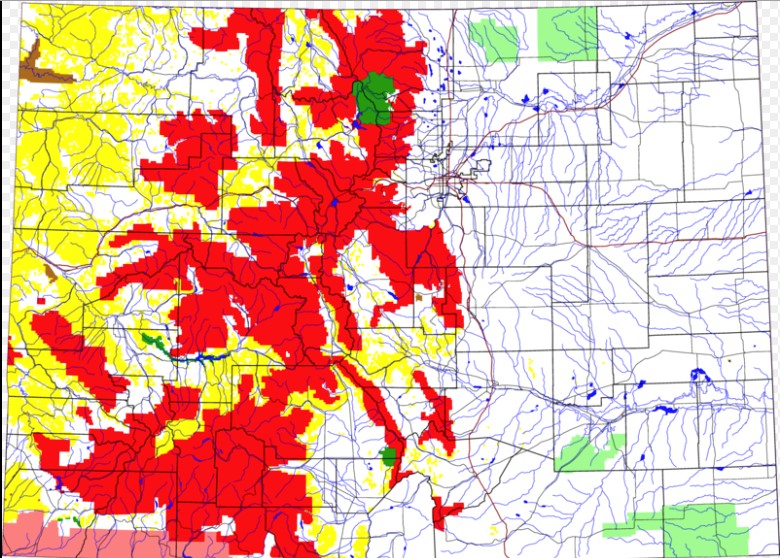 A map of Colorado, with U.S. National Forests highlighted in red. The light green is other Forest Service land (National Grassland), yellow is BLM land, dark green is National Park, brown is National Monument or National Historic Site, pink is Indian reservation. The reddish lines are Interstate Highways. David Benbennick made this map with data from nationalatlas.gov. The map uses the azimuthal equidistant projection, centered on (-105.7167, 39.1333) (degrees latitude, longitude).
A map of Colorado, with U.S. National Forests highlighted in red. The light green is other Forest Service land (National Grassland), yellow is BLM land, dark green is National Park, brown is National Monument or National Historic Site, pink is Indian reservation. The reddish lines are Interstate Highways. David Benbennick made this map with data from nationalatlas.gov. The map uses the azimuthal equidistant projection, centered on (-105.7167, 39.1333) (degrees latitude, longitude).
Fact 11: Existing Wells Are Not Affected
The 50,000 producing wells in the state will not be affected by 112. In less than two years, newer wells lose about 85 percent of their original production. So, like the Red Queen of Lewis Carroll, industry operators have to drill more and more just to stay in place. It is the industry’s Achilles heel. Being forced by depletions out of its most productive areas, the industry may have to move into urban areas along the front range, and even Denver itself.
 (Photo from Daily Camera, April 2017.)
(Photo from Daily Camera, April 2017.)
Existing wells in the front range shown by red dots.
Fact 12: The Impact On Jobs Is Minimal
Industry Propaganda: Prop 112 would cause the loss of 200,000 jobs in the state, cause economic collapse, destroy schools, and make the state a backwater.
According to the U.S. Bureau of Labor Statistics the category, Mining and Lumber, which includes coal mining, hard rock mining, lumber harvesting, sand and gravel mining, and oil and gas employs about 30,000 people statewide, or less than 1 percent of the state’s total jobs. The actual number of oil and gas jobs within that category is about 11,000 jobs. All jobs are important, of course, but the fracking industry is not the employer the industry advertises itself to be, not even fractionally. The 200,000 number it throws around apparently includes all secondary jobs, including bar tenders and even hookers. Secondary jobs would remain, even increase for solar alternatives, with a possible reduction in hookers.
By comparison, about 17,000 people are employed directly in solar and wind energy jobs, according to a June report by Environmental Entrepreneurs (E2). Another 40,000 people work in clean energy jobs such as energy efficiency, electric car sales, etc. Jobs in this sector will continue to grow as capital continues to desert fossil fuels and embrace renewables, and as investors become ever more leery of fossil fuels as a safe investment. This is particularly so since renewables with storage are already cheaper than fossil fuels, with few to none of the environmental outfall such as oil pads in neighborhoods. On this, people as diverse as noted economist and Nobel laureate Joseph Stiglitz, and retired chair of the Rocky Mountain Institute, physicist Amory Lovins, agree. The latest report from the IPCC, issued just days ago, makes the move away from fossil fuels an imperative if we wish not to reap the whirlwind.
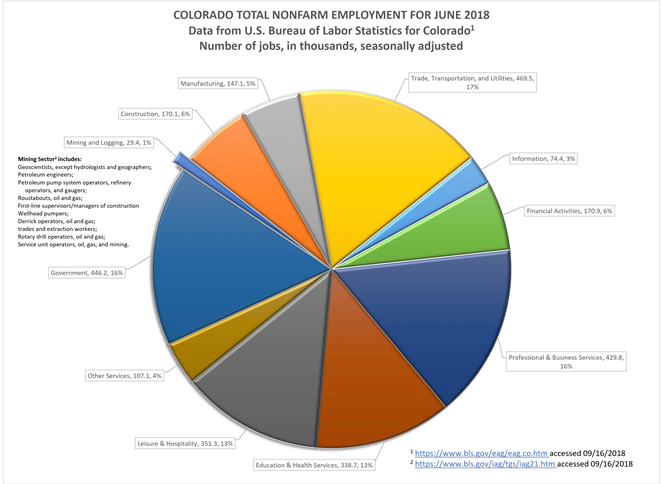
Fact 13: Oil Is A Minor Economic Driver
Another federal agency, The U.S. Bureau of Economic Analysis says the industrial sector (mining, quarrying, and oil and gas extraction) contributes about 4 percent to the state’s GDP. While this is significant regionally, it cannot be honestly labeled a driving force in the state’s economy.
As far as the Colorado economy, we didn’t do a tailspin when fracking was curtailed, beginning at the end of 2015, when oil prices dropped. In fact, in the first quarter of 2016, Colorado was 4th in the nation for GDP growth. Our growth was 3% and related to real estate, construction, and agriculture.
States that depended on O&G saw contracted GDPs. “The slump in oil and gas contributed to contractions in two states. North Dakota’s real GDP dropped 11.4 percent and Wyoming’s fell 4.9 percent. ” (Denver Post article) 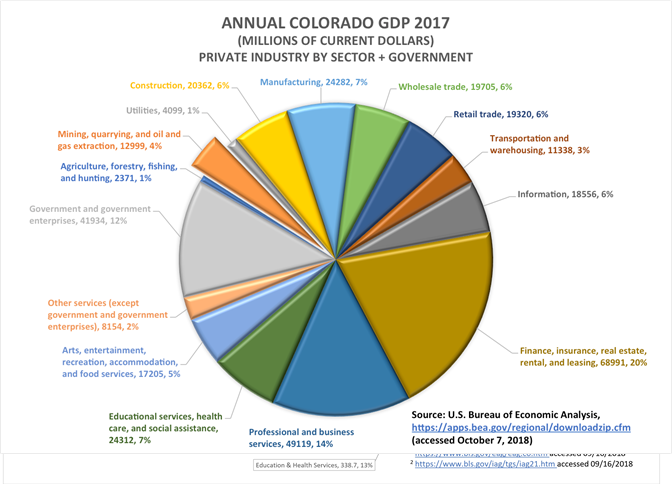
Fact 14: Severance Taxes Have Recently Been Near Zero
Information published on the Colorado General Assembly website shows how volatile revenue from severance taxes is. (Colorado Severance Tax) Unlike the clams in the ads from Oil and Gas, instead of raking in money, Colorado is at the whims of a unsteady industry. And get this: wells producing up to 15 barrels per day (oil) or 90,000 cubic feet per producing day (gas) are exempt and these companies can take a property tax credit of 87.5% of all property taxes paid except those imposed on equipment and facilities used for production, transportation, and storage.

Fact 15: Water Use For Fracking Is Not Sustainable
Industry Propaganda: Fracking uses little water. The industry and its apologists are fond of saying fracking uses but a fraction of what is used by agriculture in this state.
Fact: Fracking uses a significant amount of water. For example, with the longer laterals now being employed by the industry each frack job calls for about 10 million gallons of fresh water to be mixed with sand and chemicals. From a water planning perspective, the water used to frack one well is equal to the domestic needs of 300 people or more for one year. Anadarko is even bragging that its new fracking technique calls for even greater water and sand (propant) use.
According to a recent Duke University study, water use for fracking in the U.S. increased by 770 percent between 2011 and 2016. One estimate has the industry’s water use equal to the daily flow of water over the American side of Niagara Falls.
Commerce City is threatened with about 220 new wells. If these wells were to be drilled using 2-mile laterals, a reasonable assumption, the water required would approach, in volume, the 2.7 billion gallons the city uses annually, or 8300 acre-feet. (Note: because in water planning the volumes often run into the trillions of gallons an acre-foot is often used as a more workable measurement. An acre-foot is equal to 326,000 gallons and would fill a football field with water one foot high,) Actually, from a water resource standpoint, the industry’s impact is much greater since the water it uses is so poisoned it must be taken out of the hydrologic cycle; whereas better than 50 percent of the water used domestically gets back into the system after treatment or runoff to be used again downstream.
The threat to Commerce City’s drinking water is understood to be even greater when one factors in that the city get almost half of its water supply from shallow alluvial wells. Spills and groundwater contamination are a commonplace with fracking.
All other cities along the front range where backyard fracking is threatened and supported by state and local government are under similar threat.
Statewide the COGCC has about 5,500 drilling applications up for approval. If these wells were all drilled in the coming year, and 90 percent were horizontal wells measuring 2 miles or longer, the water requirement would nearly equal that of Denver and environs. Denver Water, the city’s publicly owned water purveyor, serves almost 1/4 of the state’s total population of over 5 million people. It supplied about 200 thousand acre-feet of treated water in 2016, page III-3. Clearly, continued destruction of the public’s most valuable resource on this scale is unsustainable and must be stopped.
Sand requirements are massive: the average fracked well can use over 4 million pounds of sand to keep open cracks so oil and gas can escape to the surface through the piping in the horizontal frack. Most of it is imported form Wisconsin by rail. Since sand weighs about 12.5 pounds per gallon, try to visualize a sand pile large enough to hold 320,000 gallons of sand, again roughly a football field covered in sand about a foot deep. With 20 or more wells on a pad, visualize a football field covered in 20 feet of sand. The mind numbs at the volumes of material required to frack.
Chemicals required are massive: The EPA reports over 700 different chemical have been used to frack, many of which are known to be toxic to humans and wildlife. The industry claims their use is insignificant since chemicals constitute only .5 to 2 percent of the total mixture. But at 10 million gallons of water per frack, that’s a lot of chemical brew—from 50,000 to 200,000 gallons. With 20 or more wells on a pad, the question begins to rise as to why the frack site shouldn’t be required to be licensed as a chemical factory?
Fracking is safe, Until It’s Not
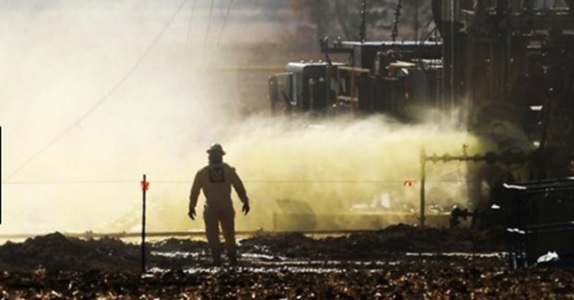
Well blow out in 2013 near Windsor, Co. Industry responder at the site us dressed in a hazmat suit. First responders were local fire fighters. Having no knowledge of the chemicals and health dangers they were facing, they were dressed in normal fire fighting gear. The waste from the cleanup was sent to the local municipal landfill without examination for radioactivity or other health dangers common to fracking waste.
Waste Disposal, A Big Red Flag: The liquid toxic waste from fracking was exempted as a hazardous waste in the Bush II administration. This exemption allowed the industry’s disposal costs to be socialized. The Obama administration let it stand without so much as a peep. As a result, the liquid waste from fracking is not sent to hazardous waste disposal sites, which would be prohibitively expensive, but allowed to be reinjected into deep groundwater reservoirs containing water too brackish to be potable without extensive treatment. Most of these wells, called Class II wells, are old played out oil wells. Something in the neighborhood of 400 are reportedly being used for toxic waste disposal.
Recent studies show that for every gallon of oil produced 10 gallons of liquid toxic waste is also produced. Indeed the volume of toxic waste requiring disposal has increased in the U.S. by 1,440 percent in the last half decade.
Some sense of Colorado’s potential waste stream from fracking can be gained by knowing that for each fracked well about 50 percent of the fracking liquids come back up immediately at completion. Liquid waste continues to come to the surface over the life of the well and must continue to be disposed of.
As related earlier, about 5,500 drilling permits are before the COGCC. If 90 percent are horizontal fracks using laterals 2 miles and longer, the immediate waste stream would be about 80,000 acre feet of liguid toxins that would have to be disposed of during 2019. The initial disposal from these wells exceeds Commerce City’s annual water use by ten times. Clearly, such a wacky, state endorsed, procedure is unsustainable and a real threat to our environment and water safety.
For emphasis as to the long-term dangers, a 2016 study of the Bakken oil field in North Dakota disclosed that:
‘Thousands of oil and gas industry wastewater spills…have caused “widespread” contamination from radioactive materials, heavy metals and corrosive salts, putting the health of people and wildlife at risk…. Some rivers and streams… now carry levels of radioactive and toxic materials higher than federal drinking water standards as a result of wastewater spills…”
This study describes the surface impacts from spills. The chance that at some future date, if not already, the waste being injected into our underground reservoirs will migrate to contaminate drinkable groundwater and surface water, even, seems almost 100 percent.
Fracking is safe, Until It Isn’t

A tanker dumping frack liquid waste on private farmland in Weld County. It’s cheaper than hauling to an injection site, and since the industry is licensed to determine if its waste is toxic on not, it is fully allowed under what the Guv calls the strongest regulations in the nation. Pity the nation.
Summary: The great American writer and naturalist, Loren Eisley said that: “If there is magic on this planet, the magic is in water.” Clearly the oil industry is unacquainted with Eisley, and the politicians, frankly, don’t seem to give a damn.
Note: to better assess the maximum potential impact on water from fracking, as throughout this fact sheet, the volumes and recipes used have been in the upper ranges of actual uses to better judge the worst case scenarios. This is a perfectly legitimate approach and one to be preferred when assessing potential human and environment risks. In the near future, if the industry doesn’t go belly up first of its own discordant greed, the numbers used here could become under estimates, since the industry has learned that hugely industrial sites of 40 wells or more reduce its costs, but not nearly to the point where it can make a profit.
More to come——–


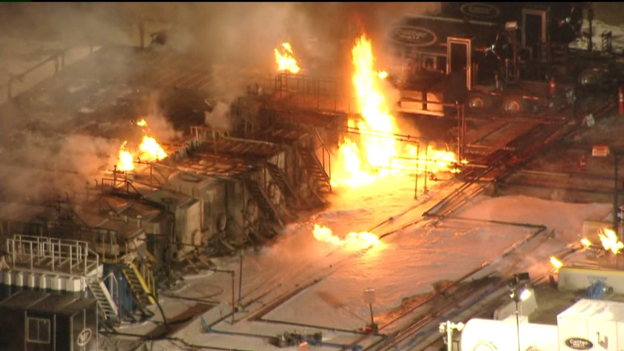
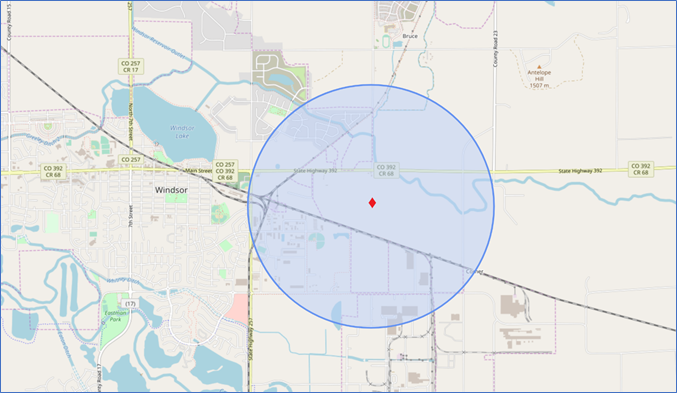



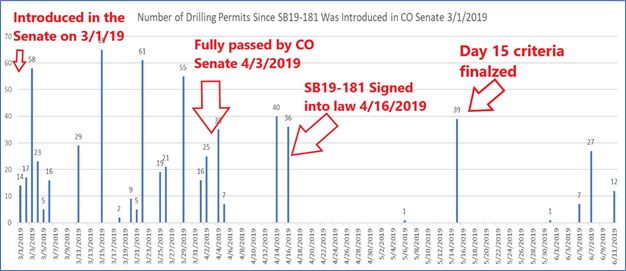
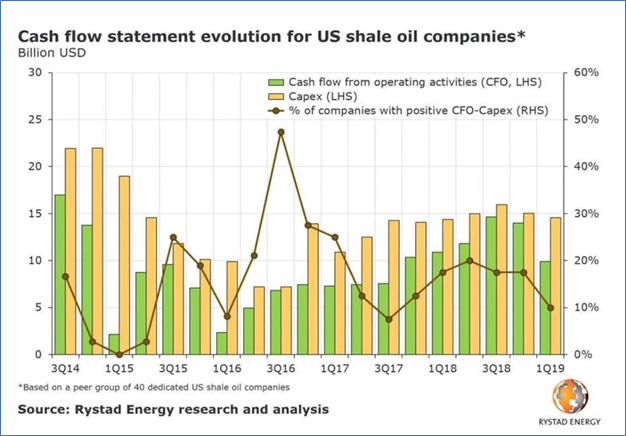


















 Commercial Landfills in Colorado have been advised that disposal of Oil and Gas Exploration and Production (E&P) waste is not exempt from Colorado Solid Waste Regulations (1), for example, 6 CCR 1007-2. Disposal of fracking waste is a nation-wide problem.
Commercial Landfills in Colorado have been advised that disposal of Oil and Gas Exploration and Production (E&P) waste is not exempt from Colorado Solid Waste Regulations (1), for example, 6 CCR 1007-2. Disposal of fracking waste is a nation-wide problem.